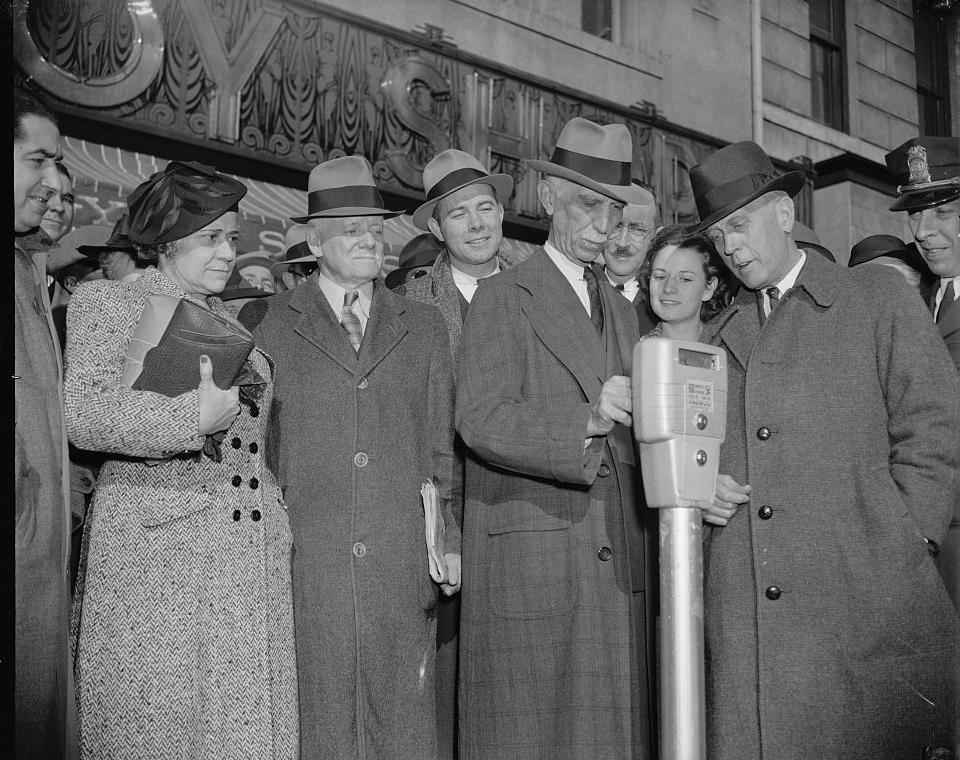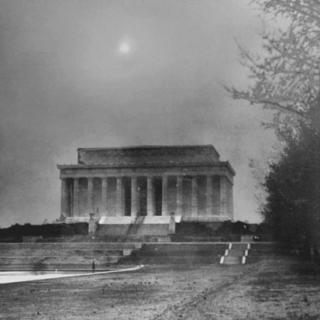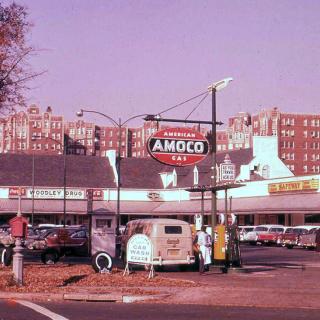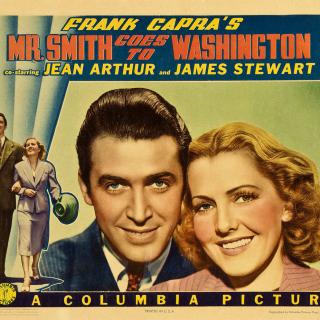When Parking Meters Were a Hot Controversy in Washington
Washington, DC has 17,000 parking meters, and the necessity of feeding them quarters — or, in the case of the newest models, a credit card swipe or electronic payment via smartphone — is one of those annoyances that urban drivers must grudgingly accept. As hard as it may be to imagine, though, there was a time in the early 20th century when the idea of installing devices to collect fees for parking spaces was opposed by the American Automobile Association and motorists who saw it as unfair taxation, and it took several years to get approval to install the first meters on District streets.
Parking was a problem in the District as far back as the early 1920s, when the automobile's surging popularity began to overwhelm downtown streets. Underground parking garages didn't yet exist, and District officials tried to cope by imposing time limits upon street parking in the most congested areas, allowing drivers to park for as little as 15 minutes in some places and up to two hours in others. But police had difficulty enforcing the rules. Police complained that they didn't have the time to watch all of the city's parking spaces to catch violators and issue summonses, and the legal validity of leaving them on windshields had not yet been established. Compliance with the rules was so bad that in 1924, District officials even considered a proposal to put chains on cars that stayed in parking spaces too long, so that their owners would be stranded until they came to the police station and pay the requisite $10 fine. One local civic group, the Midcity Citizens Association, even argued that the best way to alleviate the congestion was simply to ban automobiles from parking on downtown streets altogether.
But nothing seemed to help. In 1927, a Washington Post article lamented the plight of "the man who swerves round and round for ten blocks, amid creaking breaks, innumerable near collisions, and a great deal of cussing to find a place to park."
In the early 1930s, a solution for Washington's parking woes finally emerged in Oklahoma City, 1,350 miles from the nation's capital. As a CityLab article details, newspaperman Carl C. Magee, who first achieved fame by helping to expose the Teapot Dome scandal during the Warren Harding administration, knew local storekeepers were upset that shoppers couldn't find spaces close to their shops. Magee held a contest to pick the best device that would limit the time a car stayed in a space, and charge the motorist for it. Magee and winning designer Gerald A. Hale subsequently started the Magee-Hale Park-O-Meter Company, and installed the world's first parking meter on an Oklahoma City street corner in July 1935. What Popular Mechanics called a "clock-like contrivance" charged a nickel for each hour of parking, and indicated with a red flag when the time was expired. Local drivers complained bitterly about the Magee-Hale gadget, insisting that it put a tax on car ownership. But they ended up parking in the metered spaces anyway, out of necessity, and pretty soon storekeepers across the city wanted them in their neighborhoods. City officials took a liking to them too, once they realized that the meters were a lucrative new source of revenue.
That solution caught the attention of District Commissioner Melvin C. Hazen and traffic director William C. Van Duzer, who wanted to try it in Washington as well. Sen. Elmer Thomas, a Democrat from Oklahoma, the state where parking meters began, began trying to get necessary Congressional approval. Even though Thomas headed the Appropriations Committee, it wasn't easy. He struggled for three years to get legislation to a floor vote.
Metered parking had plenty of opponents, who saw it as imposing an unfair new tax on motorists. One particularly powerful naysayer was the American Automobile Association, an organization better known today as a provider of travel discounts and emergency help for breakdowns on the road. In a 1937 letter to Hazen, AAA's general manager, Russell E. Singer, argued that parking meters wouldn't solve downtown congestion or the "evils" of double parking, and suggested that the technology wasn't ready for such a major test.
"In view of the fact that this parking meter agitation has been raging for nearly three years and only 14,000 have been installed throughout the United States, do you think it a wise policy for the District of Columbia to install 7,000 in one fell swoop?" Singer asked rhetorically. (The organization favored an alternative method — having policemen cruise the streets in motor-tricycles and mark the tires of parked cars with chalk.)
Finally, in March 1938, Thomas and other proponents of parking meters finally managed to pass an amendment to an appropriations bill for the District, but just barely, on a voice vote in which it was questionable whether the "ayes" were louder than the "noes." The House of Representatives, however, rejected the amendment. With the District's annual funding tied up, Thomas finally managed to convince the House to go along by specifying that the parking meters were to be "experimental," limiting them to a few city blocks along E, F, and G streets, and putting a one-year time limit on the trial.
Even so, not everybody was happy with the concept. A September 1938 Washington Post editorial warned that meters might have little effect in terms of freeing up parking spaces, because a motorist could return and slip a nickel into the meter to keep from getting a ticket. Commissioner Hazen conceded, "we don't have enough police to keep an adequate check on this."
Nevertheless, in early November, workmen began installing the first of the 310 experimental meters, which cost $44.45 apiece, on downtown sidewalks. In a ceremony on F Street, Hazen deposited the first nickel ever put into a meter in DC, and proudly estimated that the gadgets would bring in about $90 in total revenue each day. A Washington Post account noted that several hundred bystanders watched the ceremonies with mixed emotions.
"I'm going to leave my car home from now on," one man angrily told the newspaper. "I pay enough taxes now and I'll be damned if I'll pay to park my car on a public street."
In the days that followed, other motorists, who may not have been following the news, reacted in puzzlement when they encountered the meters, and had difficulty figuring out how to operate them. "I thought you put the money in afterwards," one woman pleaded to police who were about to ticket her car, according to a Washington Post account. Meanwhile, the police themselves were trying to figure out how to enforce the parking regulations. They actually arrested one man, 22-year-old Robert W. Waldron, after he left his car in a parking space where the meter still showed green, after a previous motorist left before using up all the time. Waldron, the first person ever prosecuted for failing to feed the meter, got little sympathy from Judge John P. McMahon, who fined him $5.
Other motorists figured out how to beat the system. The Post reported in 1939 that seven of the city's meters on F Street, if kicked, would give 60 free minutes of parking without a nickel being inserted in them. But all in all, though, the District government was pleased. Overtime parking had dropped by 70 percent, and the meters were bringing in a third more revenue than Hazen had predicted. A survey showed that 88 percent of local businesses wanted to see the program extended. That year, District officials asked Congress to make them permanent and sought funds to install more meters.
From that point on, feeding the meter became a common part of life in the District — so much that in 1950, local radio station WWDC staged a publicity coup by sending around agents to deposit nickels in expired meters and then place notes on windshields, informing drivers that the radio station had saved them from having to pay a fine.






![Sketch of the mythical fuan by Pearson Scott Foresman. [Source: Wikipedia]](/sites/default/files/styles/crop_320x320/public/2023-10/Goatman_Wikipedia_Faun_2_%28PSF%29.png?h=64a074ff&itok=C9Qh-PE1)












